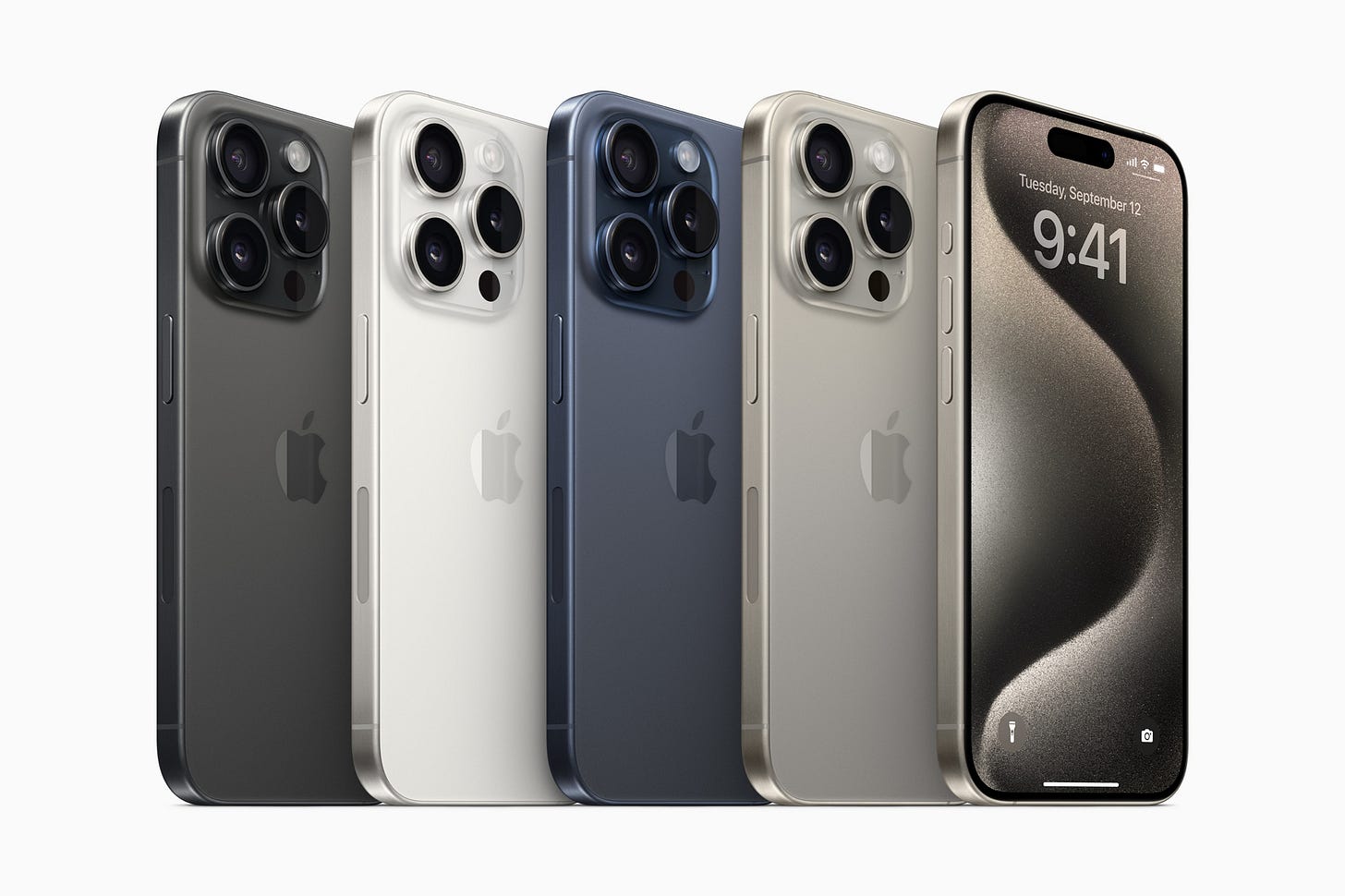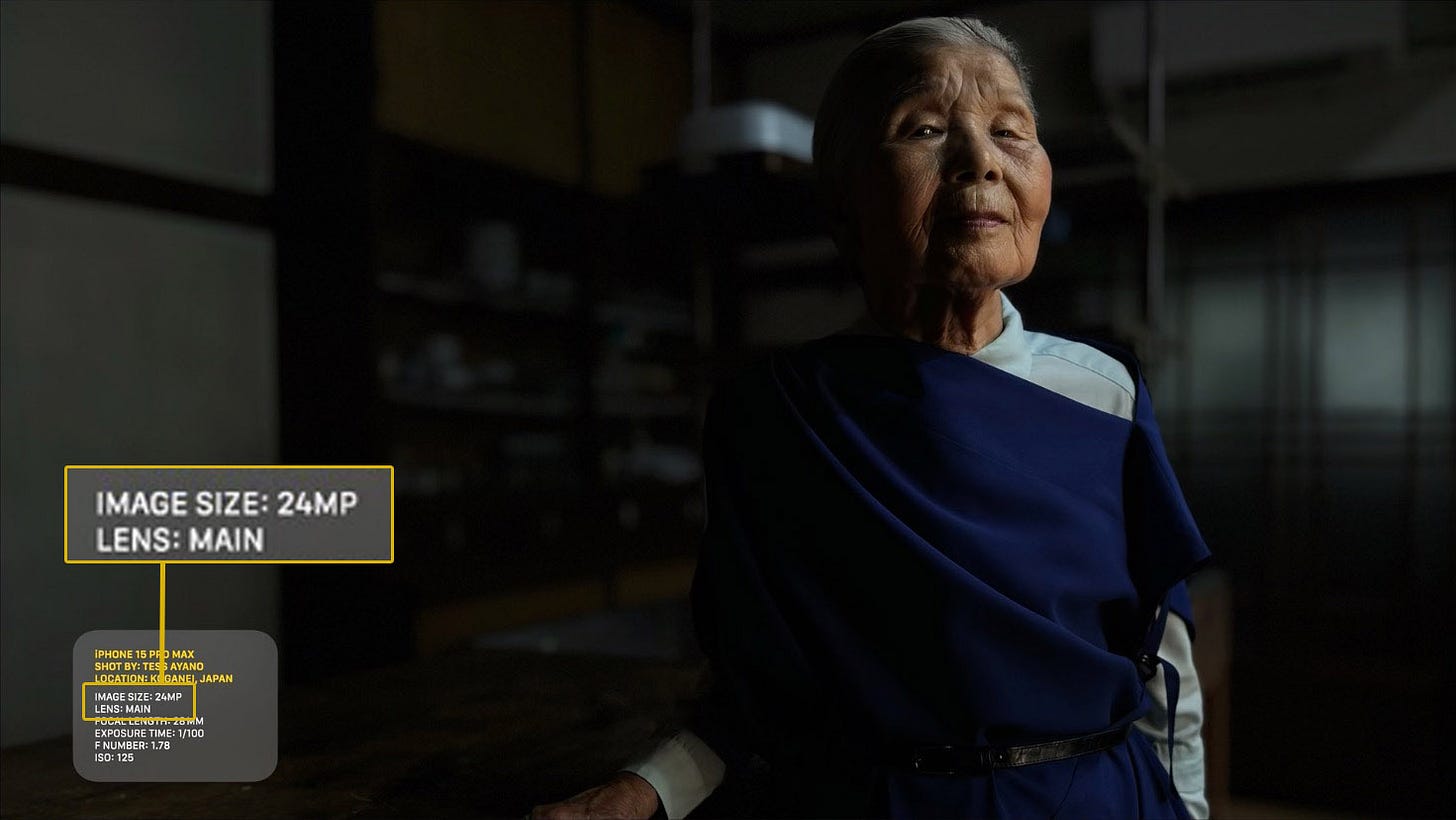Hello and thank you for subscribing to The Smarter Image newsletter (formerly known as Photo AI)! Fair warning that this is an iPhone 15-heavy newsletter, because I’ve been covering the new models since they were announced. Oh and because Apple is doing a ton of work advancing computational photography.
Please consider becoming a paid subscriber to support my work for as little as $4.17 per month. If you already support this newsletter financially, thank you! And if you aren’t contributing monetarily, I do appreciate your time and attention.
First Things
Sharp-eyed readers like you may have noticed that I’ve subtly rebranded this newsletter to its proper name, The Smarter Image. There’s more to do, but I was getting tired of calling it “Photo AI” since Topaz took that name for their product. I’ve been waiting for a better opportunity to do a full rebrand, but other work has taken precedence, so it’s better to just jump ahead than wait for perfect timing.
I was on the iPhone 15 beat at DPReview for Apple’s announcements and published three articles over the last week and a half focusing on the camera features of the new phones:
iPhone 15 Cameras: What You Need to Know: This was posted shortly after Apple’s keynote event, summarizing the main camera features.
Apple’s iPhone 15 and iPhone 15 Pro: Imaging tech examined: A couple days after the announcements, I dug deeper into the photo technologies based on what we knew at the time.
Which iPhone 15 is right for you? A look at the major features to help people determine which model they should get (including the option of sticking with what you have).
After all that, am I upgrading? Yep: I ordered the iPhone 15 Pro (not Pro Max) which should arrive today. Since I write about Apple and these technologies, I’ve been on the iPhone Upgrade Program for several years, which enables me to trade in my current phone for a new one each year. If that wasn’t the case, I’d probably stick with my iPhone 14 Pro, which has been a great phone for the past year.
iPhone 15 and iPhone 15 Pro: The Incremental Progression of ‘Default’
The big news about the cameras in the new iPhone models is rightly focused on the 48 megapixel main cameras in every model and the new tetraprism design that gives the iPhone 15 Pro Max a 5x/120mm equivalent focal range. But I’ve been just as intrigued by the level of computational photography that’s happening with every shutter press.
For several generations, the iPhone has employed machine learning technologies to improve the photos it captures and overcome the limitations of the small smartphone lenses and sensors. This year Apple made a change that pushes the built-in image processing into a higher level.
New Year’s Resolutions
On both the iPhone 15 and iPhone 15 Pro (and their Plus/Max sized variants), you can capture full-resolution HEIF or raw files at 48 MP, but that’s an option you have to specify. The default resolution is 24 MP, which is double the 12 MP default size of photos on the iPhone 14 Pro (that has the same 48 MP sensor as the iPhone 15 Pro).
Why save to a smaller default size? Don’t we want the highest resolution every time? Although the Main camera sensor is 48 MP, we’re still talking about a very tiny piece of equipment: it measures just 9.8mm by 7.3mm on the Pro models, and even smaller 8mm by 6mm on the iPhone 15 and 15 Plus. Packing more photosites into that space means each one is extremely tiny. To enhance light and color detection, the iPhone takes groups of 4 pixels and makes them work as one larger pixel (a process called pixel-binning). If we do the math, that means a pixel-binned 48 MP sensor creates 12 MP images (48 divided by 4 equals 12).
And yet, the new iPhones are outputting 24 MP default images. During capture, the sensor creates an optimized 12 MP pixel-binned image using Apple’s Photonic Engine technology, which is a combination of exposures and analyses to maintain sharpness, reduce noise, blend light levels, and identify elements such as people or skies. What’s new with the iPhone 15 models is an additional step that combines the optimized 12 MP image with a 48 MP reference image to create the 24 MP photo that shows up in the Photos library.
Double Dozen Default
Saving 24 MP images is certainly interesting, but I’m more intrigued by the fact that it’s the default resolution. From what I can tell—I don’t yet have an iPhone 15 to check—there’s no option to shoot at the 12 MP size using the Main camera. You can switch to HEIF Max or RAW Max (48 MP), or HEIF 24 or RAW 24 (24 MP). (The Ultra-Wide and Telephoto cameras still have 12 MP sensors and create 12 MP images.)
Apple is confident enough in the technology to make 24 MP the only option. It’s not giving us the choice to save 12 MP images and use less processing.
We’ve seen this before. In 2016 the iPhone 7 added a Smart HDR option you could toggle on or off in the Camera settings. The idea was that in most cases the Camera would use image fusion to capture several frames of a scene at different settings, merge them together computationally, and present the merged version as the final photo. But if you didn’t like the results, or felt as if the feature was being too aggressive, you could turn it off. These were the early days of Apple’s push to computational photography.
However, when the iPhone 8 and iPhone 8 Plus were released the following year, that setting disappeared. Smart HDR became a baked-in technology, and if you wanted to avoid it, you needed to use a third-party app. I wrote an article for DPReview about this at the time, with some good examples (particularly in the skies) of the feature at work: HDR is enabled by default on the iPhone 8 Plus and that’s a really good thing.
Keep in mind that the 24 MP resolution applies only to images captured using the Main camera, not the Ultra Wide or Telephoto. Night mode photos, even made with the Main camera, remain at 12 MP. Live Photos are 24 MP.
The real question is whether the 24 MP images will be of sufficient quality, though we won’t know that until we start seeing people’s photos. I’m also curious about how the iPhone 15 Pro handles low-light situations with the Telephoto camera. In the past, if the phone doesn’t think there’s enough light, it would switch to the Main camera and digitally crop to match the same field of view as the Telephoto lens. But with the iPhone 15 Pro Max’s 120mm equivalent Telephoto, would the phone take a tiny slice of the Main camera sensor and upscale that to 12 MP? I’m sure we’ll find out.
Many reviewers are decrying the cameras in this year’s models as not being enough of a leap forward (aside from that 5x/120mm Telephoto), but that to me seems like focusing just one a limited set of specifications. The real story is Apple’s steady push into broad computational processing to genuinely create photos, and not just record them. That’s a big deal.
Podcasts
A new episode of the Photocombobulate podcast is now available:
Episode 32: Travel Has Changed: Anyone who has travelled by air lately has probably noticed that things have changed. Flights are chronically overbooked and flight crews are running out of patience with passengers dragging massive bags they insist are carry-ons. For those of us traveling with camera gear, it’s a great time to plan ahead for less room in overhead bins. In this episode Mason and Jeff discuss several things they’ve started doing differently when they fly.
In an age of diminishing space, there are several strategies you can employ to make travel easier. Jeff and Mason talk about luggage considerations, packing hacks, and how to pare down one’s camera kit for a more enjoyable adventure.
(PhotoActive is taking an episode off. Our next one will be published on September 29.)
Further
Fall is definitely a busy season, and I’m having trouble believing that it’s already almost October. But at the same time, it’s my favorite season, which is why I’ve launched a new personal project that I have had in mind for several years.
I get really excited about the changing leaves and fall color, and as a photographer I have lots of autumn photos that I love. So I’d like to share an experiment: my Autumn 2023 Collection of photo prints. I’m selling packs of three 5x7 photos, printed on beautiful Moab Entrada Rag Bright 190 paper, a 100% cotton fine art acid-free stock, and available at affordable rates (less than what I charge for larger prints). My plan is to make them available only during the fall, and then the Collection goes away. And if this is successful, I’ll choose new images next year.
View (and order!) them here: The Autumn 2023 Collection. This is all my own work, printed by me, so your purchase supports an independent creator.
Let’s Connect
Thanks again for reading and recommending The Smarter Image to others who would be interested. Send any questions, tips, or suggestions for what you’d like to see covered at jeff@jeffcarlson.com. Are these emails too long? Too short? Let me know.






